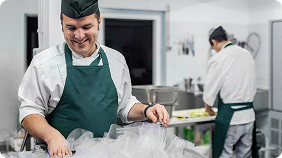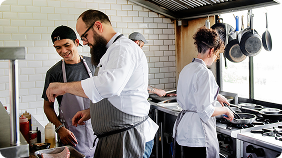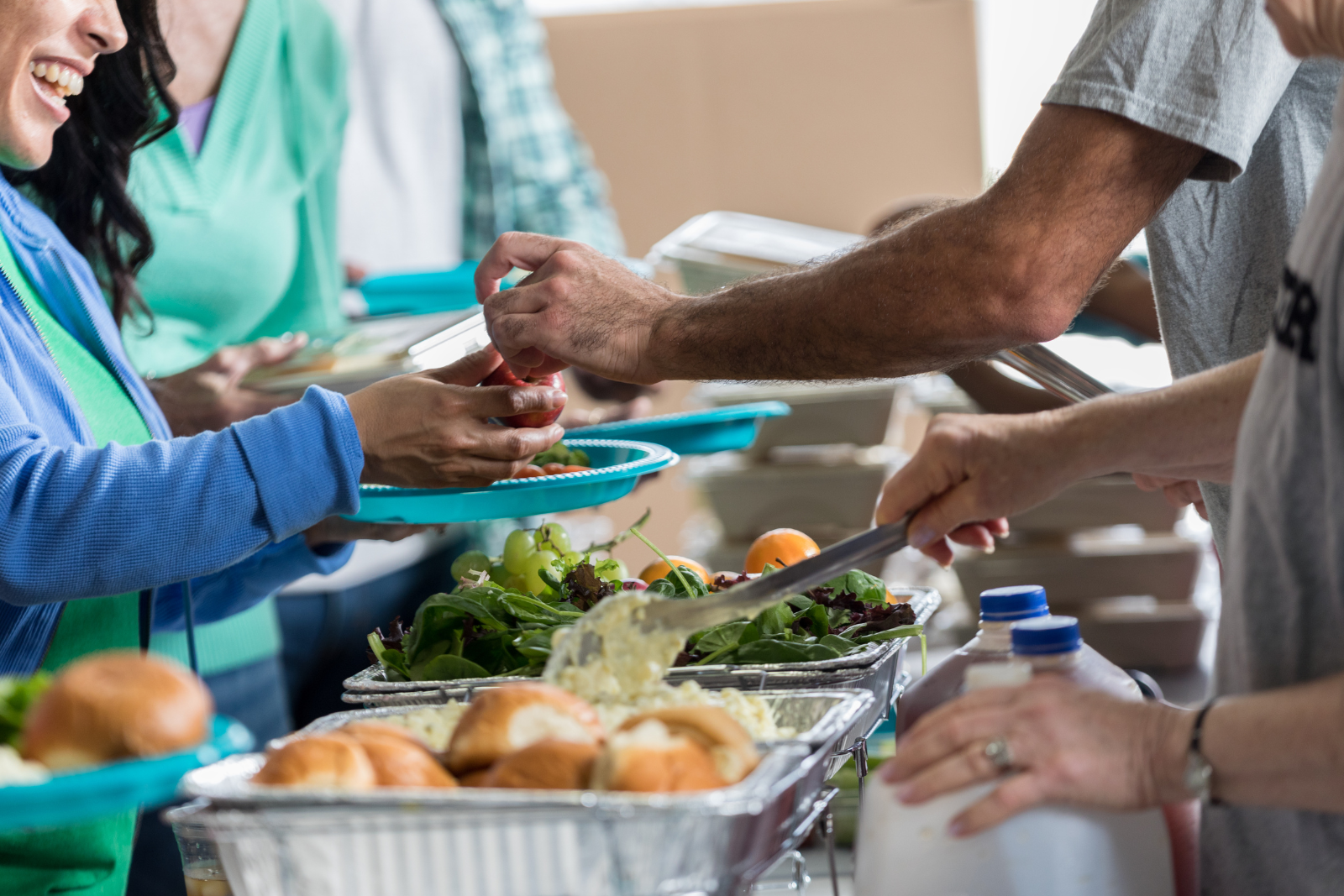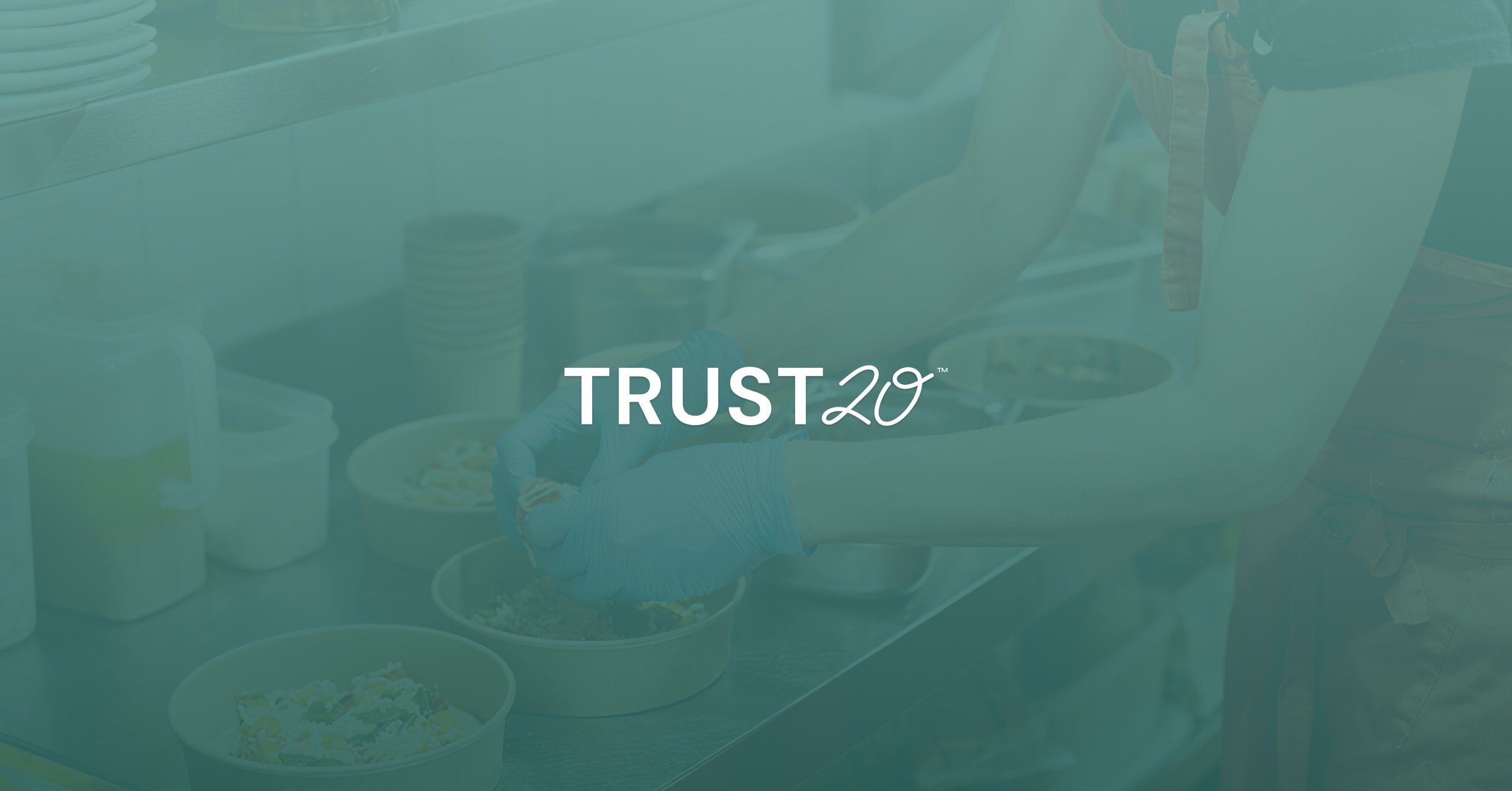The holiday season tends to bring out the best in us. We feel a pull to give back, to share our good fortune with those who have less.
For many, that means donating food or volunteering our time at a local charity. It’s a beautiful impulse that strengthens communities, and one you should by no means avoid.
But as you’re packing up those cans or heading out to serve a meal, there’s one ingredient for Thanksgiving Day success that you might not be considering: food safety. As a foodservice professional, you already know how important proper food handling is. Now, let’s talk about how you can apply that expertise where it’s needed most, especially during peak giving seasons.
Ultimately, it’s about so much more than good practice; it is about protecting vulnerable people and making sure our generosity helps, not harms. Let’s take a closer look at how you can make a real difference in your community’s charitable food programs.
We'll cover:
What is the role of charitable food programs?
What are the foodborne illness risks in charitable food programs?
How does volunteer turnover impact food safety?
What are best practices for food safety in charitable food programs?
What does the legislation say about safe charitable food programs?
Your role as a foodservice professional
What is the role of charitable food programs?
You’re probably somewhat familiar with the complexities of the food supply chain from a commercial standpoint, since you’re working in this capacity already.
Charitable food programs, sometimes referred to as Food and Agricultural Nonprofit Organizations (FANOs), operate within a unique and frequently challenging segment of that chain. These organizations, which include food banks, pantries, soup kitchens, and meal programs, are on the front lines of two major issues: food insecurity and food waste.
In 2022, 12.8% of U.S. households were food insecure, meaning they lacked consistent access to enough food for an active, healthy life. At the same time, an estimated 30 to 40% of all American food goes to waste each year. FANOs work diligently to bridge that gap, redirecting wholesome, surplus food to people who need it most.1
Yet these programs face significant challenges, often operating with decentralized systems and an unpredictable flow of donations. One of the biggest hurdles, especially when it comes to food safety, is a heavy reliance on volunteers with little or no formal food safety training. A large pool of inexperienced volunteers creates a situation in which good intentions can lead to devastating unintended consequences.
What are the foodborne illness risks in charitable food programs?
As you know, the consequences of poor food safety can be severe. Over 200 different diseases can be transmitted through food, with some of the most common culprits being noroviruses, Salmonella, and Clostridium perfringens. While a foodborne illness is miserable for anyone, it poses a much greater threat to the vulnerable populations that charitable organizations often serve, including children, older adults, and people with compromised immune systems.2
Though they aren’t always widely publicized, outbreaks linked to donated food are a real danger. Recent reports highlight incidents involving donated chicken contaminated with Salmonella, for example, and even recalls of items like peanut butter rocked the charitable food system in the past.2
An outbreak doesn’t just cause illness; it can also shatter public trust in an organization. And for a nonprofit that depends on community support and donations to survive, a food safety incident could jeopardize its entire mission.
How does volunteer turnover impact food safety?
Just imagine your restaurant or cafeteria trying to operate with a brand-new staff, every single day (and very few of them have ever worked in foodservice before). Unfortunately, that’s the reality for many charitable food programs. They depend on a constant stream of volunteers to sort donations, prepare meals, and distribute food.
Volunteer turnover is incredibly high. A study of the Second Harvest Food Bank of Central Florida in 2022 found that it utilized 39,138 volunteers, each of whom worked for an average of only three hours that year..2
You can’t build expertise or institutional knowledge with that level of turnover. And in a single community, a donated food item might pass through more than 100 small charitable organizations.3 Many of these volunteers have wonderful hearts, but limited food safety knowledge. The constant churn makes it almost impossible to maintain consistent training and practice.
All in all, this gap between the need for skilled handling and the reality of a transient volunteer workforce is one of the biggest risks in the charitable food sector.
What are best practices for food safety in charitable food programs?
Your professional experience gives you a deep foundational understanding of the practices that can best mitigate the risks described above. After all, the core principles of food safety are universal, whether you’re running a five-star restaurant or a community soup kitchen. Here are a few ways they apply in a charitable setting.
Food handling and storage
The food donation process involves several key steps: identifying surplus food, repackaging and labeling it, transporting it, receiving and assessing it, and finally, distributing it. There are potential hazards introduced at each of these steps.3
Volunteers must follow time and temperature control best practices with precise care. Organizations must use reliable refrigeration and transport solutions to keep perishable items out of the temperature danger zone (41°F to 135°F) to prevent bacterial growth.
Preventing cross-contamination is another crucial element. Anyone putting food in the cooler should store raw meat separately from and below ready-to-eat foods, and your volunteers need to understand the importance of using different cutting boards and utensils for different food types.
Someone must carefully inspect all donated food; discard cans with dents, swelling, or rust, and packaged goods with torn or compromised seals are likewise unsafe. Again, volunteers need to know what to look for.
Volunteer training and infrastructure
Because of high turnover, training can't be a one-time event. It needs to be simple, consistent, and ongoing.
As a foodservice professional, making sure you and your staff are up to date with the latest in food safety (ideally, by exploring one or more of Trust20’s training products) is a great way to build a leadership team that can instill basic principles in new volunteers. Of course, encouraging repeat volunteerism can also help you build a core group of experienced helpers.
The right infrastructure is also essential, as FANOs need adequate refrigeration and freezer space, proper shelving for dry goods, and clear systems for labeling and dating food. As such, adhering to "first in, first out" (FIFO) principles ensures the use of older donations before they expire.
What does the legislation say about safe charitable food programs?
If your foodservice establishment is planning on running a charitable food program this season, you may feel intimidated by the hefty liability that comes with doing so. There’s often ambiguity about how foodservice providers can apply food safety rules to donated food versus commercially sold food.
Fortunately, there is a key piece of federal legislation that encourages food donation: the Bill Emerson Good Samaritan Food Donation Act.4 This law protects individuals and organizations from civil and criminal liability should a product they donated in good faith later cause harm to a recipient. This protection applies as long as donors provide the food without gross negligence or intentional misconduct. Understanding this act can help reassure organizations and individuals who are hesitant to donate surplus food.
Collaboration is key when managing any charitable food program. FANOs or even one-time charitable donors can benefit greatly from partnering with local health departments and food safety organizations. These public-private partnerships can provide access to training, resources, and expert guidance, helping build a stronger, safer charitable food system for everyone.
Your role as a foodservice professional
As a foodservice professional, your expertise is a powerful resource that can help bridge the knowledge gap in many charitable food programs. You already understand the “why” behind the rules, and you can communicate it in a practical, accessible way.
Consider these steps to help you make an even bigger impact:
-
Volunteer Your Expertise: Offer to conduct a simple food safety audit for a local food pantry or soup kitchen. You can help them identify potential risks and develop straightforward solutions.
-
Become a Trainer: Create a short, simple training session for volunteers. You can cover the basics of handwashing, temperature control, and cross-contamination in a way that’s easy to remember.
-
Share Resources: Connect local nonprofits with reliable food safety resources. You know where to find the best information, whether it's from the health department or professional organizations.
-
Advocate for Standards: Use your voice to advocate for standardized, accessible food safety training for all volunteers in your community’s charitable food system.
Your knowledge is one of the most valuable things you can donate. By sharing it, you can help ensure that every meal is safe.
Ready to make a difference this holiday season?
The spirit of giving is a powerful force for good. And by adding your professional knowledge of food safety to the mix, you can help protect your community’s most vulnerable members and ensure that charitable efforts are both generous and safe. You can turn good intentions into great outcomes, and that’s amazing.
Need a refresher on how to handle, prepare, store, and serve food safely? Visit Trust20 to view our food safety training programs tailored for foodservice professionals just like you. Together, we can provide safe, nutritious meals for all.
FAQ
What are the food donation regulations?
The federal Bill Emerson Good Samaritan Food Donation Act broadly shields food donors from liability. However, state and local regulations for food handling and safety still apply, so charitable organizations need to partner with their local health departments to ensure compliance.
Why is it important to follow a food safety program?
A food safety program provides a systematic approach to preventing foodborne illness. It establishes clear procedures for everything from receiving and storing food to preparing and serving it. Following a program provides consistency, reduces risks, and protects the health of both volunteers and recipients.
What is the importance of food safety in charitable food programs?
Food safety is critical in charitable food programs because they often serve vulnerable populations, such as children, older adults, and those with weakened immune systems, who are at a higher risk for severe complications from foodborne illness. Following food safety protocols protects these individuals, maintains public trust, and allows these vital organizations to continue their mission.
Sources:
- EPA: Food Donation Basics
- International Association for Food Protection: Ensuring Food Safety among Food and Agricultural Nonprofit Organizations: A Review of Literature about Challenges and Opportunities
- National Environmental Health Association: Food Donation and Food Safety: Challenges, Current Practices, and the Road Ahead
- US Government Publishing Office: Public Law 104–210 104th Congress An Act






.png)
.png)
